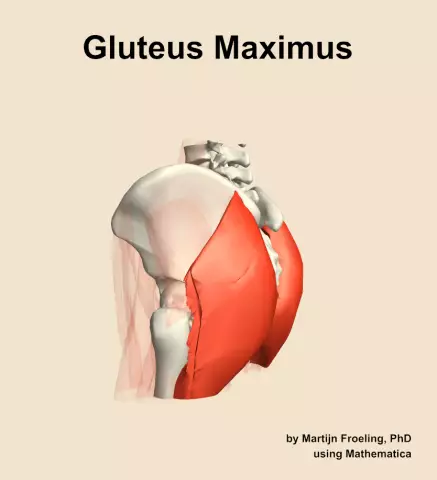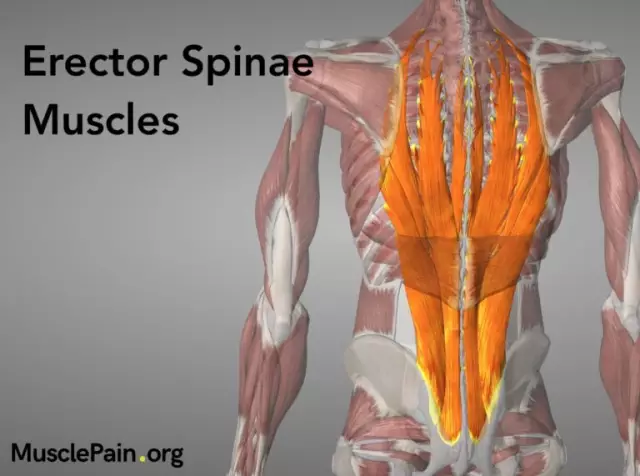- Author Curtis Blomfield [email protected].
- Public 2023-12-16 20:44.
- Last modified 2025-01-23 17:01.
"Riolan's Bouquet" - so beautifully (named after a French doctor) in anatomy is called a set of muscles and ligaments that extend from the styloid process of the temporal bone. In the "bouquet" - the stylomandibular, stylopharyngeal, styloglossus and stylohyoid muscles of the neck. In the article, we will consider the functions of the latter.
General concept

Only those who studied human anatomy have heard about this muscle, and therefore the name - the stylohyoid muscle - is hardly known to anyone. It is not large in size. It starts directly from the styloid process of the temporal bone (SHO). And below it is attached to the posterior end of the warping of the hyoid bone. In addition, her tendons from below are closely intertwined with the tendons of the digastric muscle.
This muscle is supplied with blood by the facial and occipital arteries. It is important to note that this muscle is activated by the facial nerve.
Function

The stylohyoid muscle is involved in human speech activity and this is its main function. She pulls up, back and uphyoid bone, which allows the latter to move in these directions.
Like other supra- and hyoid muscles, the stylohyoid takes part in the acts of chewing food and swallowing, stretches the oral cavity. Also takes part in the work of the digastric muscle. And sometimes it is very difficult to distinguish the meaning of each of them.
In other words, the stylohyoid muscle is very significant. It is an important component of the whole apparatus, complex in composition and structure. It includes the larynx, trachea, hyoid bone and lower jaw.
Can it cause pain?
Since the stylohyoid muscle, like many other muscles, ligaments, nerves, blood vessels, is anatomically closely related to the styloid process of the temporal bone, many researchers come to the conclusion that it can become one of the causes of the syndrome of the same name.
In what cases can the stylohyoid muscle be suspected of inflammation? Symptoms indicating it:
- Pain in the throat, neck (unilateral or bilateral), behind or under the tongue.
- Difficulty swallowing (complaints that something is in the throat).
- Neck pains that radiate to the temple, jaw, face, ears.
- Nausea, vomiting, dizziness.
- Pain after prolonged and intense chewing.
As a rule, the patient turns to a variety of specialists: dentists, neurologists, otorhinolaryngologists. And I must say that there is a sound explanation for all these actions. After all, the styloid process is surrounded by various tissues - nerve plexuses, blood vessels, musclesand can compress the walls of the pharynx, cause pain in the neck and mouth, on the face, disrupt blood circulation. But most often, such symptomatic treatment does not bring relief and is ineffective. This syndrome causes a lot of suffering in patients, turning their life into a continuous struggle with pain.
In medicine, the combination of the above symptoms is called Eagle's syndrome.
One of the culprits of the pain
For a long time among medical scientists it was believed that the cause of the stylohyoid syndrome is an abnormally long styloid process, as well as its significant deviations in size. Numerous studies have shown that not everything is so simple. For example, it turned out that pain also occurs in those whose length is normal, and there are no other anomalies of this muscle complex.

It became clear that the reasons lie not only in the fact that the process, mechanically irritating neighboring tissues, causes discomfort. It was also something else.
The reason often turned out to be that the ligaments that are attached to the process (including the stylohyoid muscle), even slightly damaged, can cause pain. Their injury can occur with a strong yawn or with a long, wide-open mouth (during medical procedures and in dental offices).
Doctors now know for sure that anomalies in the development of this complex (found in almost 30 percent of adults) can only be one of the causes of a severe syndrome. The rest of the list of pathologies of the stylohyoidneck muscles is:
- a state of spasm;
- muscle ossification;
- fused hyoid bone, stylohyoid ligament, SHO temporal bone.
Diagnosis
All of the above variety of clinical manifestations and symptoms affects the complexity of the diagnosis of Eagle's syndrome. The disease is not well understood and described. It is extremely rare for poorly informed practitioners to make this diagnosis in the early stages of their patients' torment.

An objective picture of the anatomical "relationships" between the styloid process of the temporal bone and its immediate surroundings, as a rule, is revealed when X-ray and computer studies, MRI are prescribed. Treatment is prescribed depending on the results of the tests and the causes of the symptoms of the disease.
Such patients should first of all turn to neurologists, who, if a pathology not related to their speci alty, can be referred for further treatment to other doctors.






